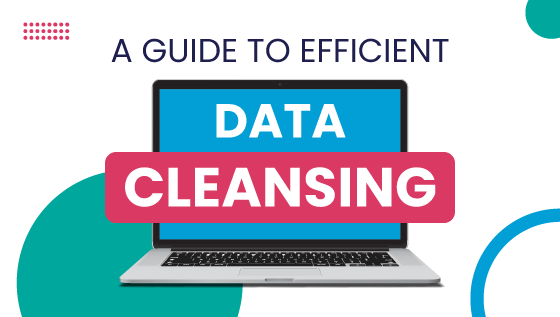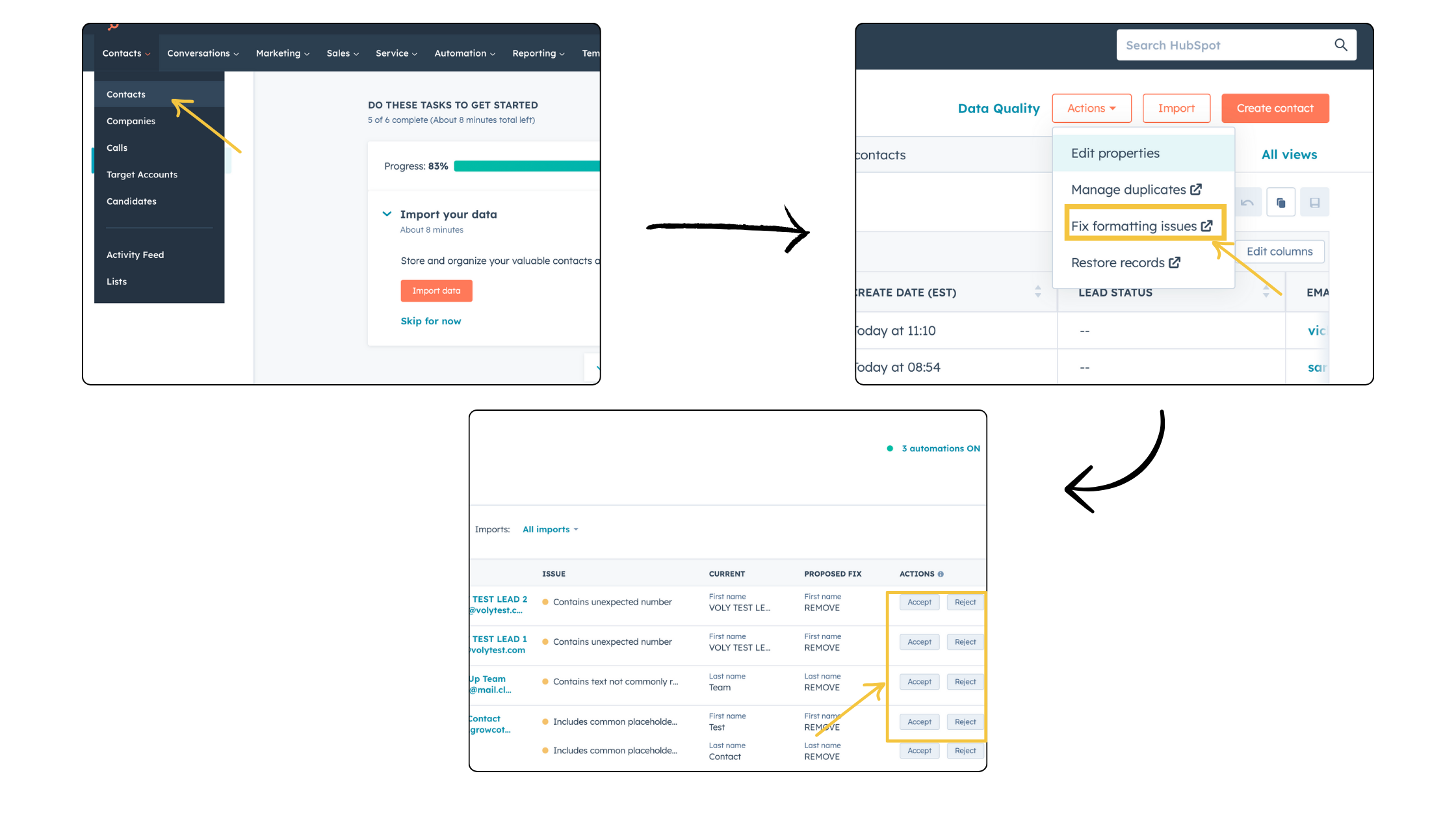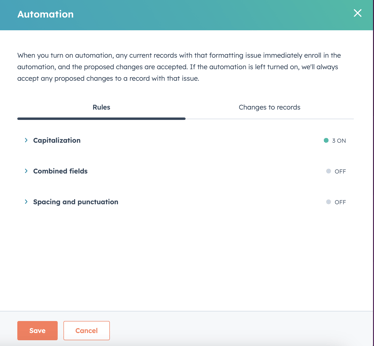






Customer relationship management (CRM) systems are critical in maintaining and enhancing customer interactions. However, the power of your CRM system is significantly influenced by the quality of your data. This is where the importance of data cleansing comes into play, not just to declutter your CRM database, but to pave the way for improved sales forecasting, targeted marketing, and streamlined operations.
In this blog, we'll delve into some basics of data cleansing, how HubSpot's Operations Hub simplifies the often daunting data cleansing process, and why this practice is relevant to eliminate waste in your business operations.
Why Data Cleansing?
Picture yourself launching an all-encompassing marketing campaign, which you've been working on for weeks - creating strategy, mapping out the budget, getting approvals, gathering all assets, etc. and when you finally put it together you realise that your Customer Relationship Management (CRM) system is cluttered with obsolete, duplicate, or missing data.
This obstacle that arises could have been easily prevented, causing additional delays in the campaign launch and creating an administrative task that nobody would willingly undertake during this crucial period.
That's where data cleansing or data scrubbing comes into play. By ensuring data cleanliness, you're not just decluttering your CRM database, but also paving the way for improved sales forecasting, targeted marketing, and streamlined operations.
Data cleansing, also known as data scrubbing, is a vital strategy that maintains the hygiene of your data. It involves identifying and rectifying inaccuracies, discrepancies, and errors in datasets. This process ensures that your information is not just accurate, but also consistent and reliable.
Data cleansing fundamentally transforms and declutters your CRM system by removing duplicates, filling in missing data, and correcting errors. By doing so, it enhances the integrity of your data, leading to more precise insights, better decision making, and ultimately, superior business outcomes.
Data Scrubbing Made Efficient
The data cleansing process can often seem daunting to operations professionals, due to its technical and time-consuming nature. It typically involves working on and organising multiple spreadsheets and crafting meticulous code to pinpoint the areas where your records are incomplete or incorrect.
However, with HubSpot Operations Hub, this process is significantly simplified. This tool allows you to take control of your data, ensuring it's clean, clear, and well-organised.
With the Operations Hub, you can automate various aspects of the data cleansing process:
- It can help you in deduplicating contact and company records.
- Fix case issues in your contact records.
- Automating formatting across various HubSpot properties.
- The Data Quality Command Center feature helps in maintaining a healthy database.
We'll go through each of these aspects one-by-one now:
Deduplicate contact and company records
Duplication of data within a CRM system can lead to significant costs in terms of both time and resources. It not only hinders productivity by forcing team members to sift through redundant or incorrect data, but it can also negatively impact customer experience.
Imagine a scenario where a sales representative contacts a customer regarding a potential purchase, unaware that the same customer had already been contacted by another team member for the same reason. This could lead to customer dissatisfaction and harm the company's reputation.
HubSpot CRM users gain a significant advantage with their built-in Duplicate Management tool. This tool streamlines the process of identifying and merging duplicate contact and company records, ensuring that your database remains clean and clutter-free.
The duplicate management tool in HubSpot, available for Professional or Enterprise users, compares records based on various criteria like names, email addresses, and more. It utilises machine learning to improve duplicate identification over time. To access the tool, go to Contacts or Companies, click Actions, and select Manage duplicates. The tool displays up to 2,000 likely duplicates, recalculated every few weeks.
To customise comparisons, go to the top of the table, select properties, and review possible duplicates. To merge, click Review, compare properties, select the record to keep, and click Merge. For Operations Hub users, the process is automated, with options like merging based on engagement date or creation date.
After merging, the primary record retains data, and the secondary record merges into it. Merged records cannot be unmerged. Regularly review and clean up duplicates for database efficiency. The initial process may take time, but regular auditing improves scalability.
Fix case issues in your contact records
To maintain personalised but scalable marketing and sales outreach, cleaning CRM data is essential. Resolving case issues makes it easier for your team to navigate through the CRM while ensuring that when personalisation tokens are used customers receive correctly written names. In HubSpot, super admin users can address case issues on contact records to enhance searchability and ensure consistency in personalisation tokens used in emails or content.
To address formatting issues in HubSpot:
- Navigate to Contacts in the dropdown menu.
- Click Actions and select Fix formatting issues.
- View and accept/reject recommendations for formatting issues in the Contact Formatting tool.

And if you have an Operations Hub Professional or Enterprise subscription, you can skip the tedious task of manually acting on each recommendation by automating the resolution of case issues in contact records through tailored formatting rules.
By accessing the Automation section in the top right, you can navigate to the Rules tab in the right panel and select specific formatting rules, such as Capitalise First Name, to activate automation. This ensures that records with the identified formatting issue, like a lowercase first name, are automatically corrected upon entry into the CRM.

To customise automation preferences, toggle the checkbox to turn on or off specific rules based on their requirements. The Changes to records tab allows users to review and filter all records updated by the automated rules, providing transparency and control over the automated processes. After configuring these rules, users can save their settings for ongoing automation.
Whether deploying targeted marketing emails or sales sequences, these tokens facilitate tailored interactions that address customer pain points, needs, and challenges at scale, ensuring each lead interaction remains relevant and personalised.
Automating formatting across HubSpot properties
Data quality automation in HubSpot ensures effortless and automatic cleaning of dirty data, freeing up the operations team to focus on growth initiatives. The automation involves workflow actions that format property values, such as capitalising letters, fixing date properties, and updating phone numbers.
Data Quality Automation in HubSpot streamlines the correction of formatting issues in contact records through a systematic process:
-
Assessment: Identify formatting discrepancies in contact data.
-
Standardisation Rules: Define rules for consistent formatting.
-
HubSpot Automation: Use HubSpot workflows or third-party tools integrated with HubSpot for automation.
-
Triggers: Set triggers based on events like new contact creation or field updates.
-
Data Cleaning Actions: Implement actions for search and replace, date and time formatting, and regular expressions to correct formatting issues.
-
Validation Steps: Include validation steps to ensure compliance with standardisation rules.
-
Logging and Reporting: Implement logs to track changes made during the automation process.
-
Testing: Conduct thorough testing on a subset of data before deploying automation at scale.
-
Scheduled Execution: Set up scheduled or real-time execution to maintain consistent data formatting.
-
Monitoring and Maintenance: Regularly monitor and adjust the automation process to adapt to changing data standards.
By following this process, organisations can ensure that contact records are consistently formatted, leading to improved data quality and more effective marketing and sales operations.
This feature showcases the immediate impact of data quality automation on maintaining a cleaner database, enhancing efficiency, and reducing data-related challenges.
The Data Quality Command Center
HubSpot's Data Quality Command Center serves as a centralised hub for proactive data health management in your CRM. Only accessible to users with super admin permissions, this command centre, located in the Reports dropdown menu under Data Management, offers an all-in-one dashboard providing insights and tools for addressing data-related issues.
This centralised hub, found in the Reports dropdown menu under Data Management, is exclusively available to users with super admin permissions. It serves as a comprehensive dashboard, offering a range of insights and tools to effectively tackle any data-related challenges that may arise. Key features of the Data Quality Command Center include:
1. Properties: Provides valuable insights into the total number of properties associated with contacts and companies, along with daily trend reports highlighting any property-related issues. It also identifies properties that have no data, are unused, or have duplicates, allowing users to easily investigate and access detailed information by clicking on "View all Property Insights."
2. Records: Compiles comprehensive information about the total number of contact and company records, accompanied by daily trend reports that flag any record-related issues. It specifically identifies records that have formatting problems or duplicates. Users can conveniently address these issues by clicking on the specific problem, which will direct them to the relevant tools such as Contacts Formatting or the duplicate management tool.
3. Data Sync: Provides detailed information about the total number of connected data sync apps, with daily trend reports highlighting any data sync issues. It also identifies apps that have sync failures or no active syncs. Users can explore additional insights by clicking on "View all Data Sync app insights."
The Data Quality Command Center empowers users to take proactive measures in managing data health by identifying and resolving various issues, including unused properties, formatting problems, duplicates, and data sync errors. All of this can be done through a centralised and user-friendly interface, ensuring efficient data management.
Minimising Waste
Data cleansing plays a crucial role in optimising business operations, minimising wastage, and enhancing efficiency. It ensures that the data held within the CRM is accurate, up-to-date, and relevant, which leads to informed and strategic decision-making. A clean dataset reduces errors caused by inaccurate information, thereby minimising wastage in the form of time and resources spent rectifying these inaccuracies. Moreover, it optimises people's productivity because employees no longer need to spend unnecessary time sorting through cluttered and misleading data; instead, they can focus on performing tasks that add value to the business.
Processes are streamlined when the data is clean and reliable. Decisions can be made quickly and confidently, reducing delays and bottlenecks. Automation of data cleansing also plays a part here, as it allows for continuous and proactive management of data health, further reducing the chances of error.
In terms of technology, data cleansing reduces the load on CRM systems. By eliminating duplicates and irrelevant data, the CRM operates more efficiently and provides better results in terms of reporting and analytics. It also improves the effectiveness of integrations with other systems, ensuring accurate data syncing and eliminating the risk of system errors or crashes due to poor quality data. Overall, by maintaining a clean and high-quality database, businesses can optimise operations, minimise wastage, and maximise the value of their CRM investment.
Thorough data cleansing and decluttering of CRM systems, facilitated by automation features in HubSpot, results in a streamlined and efficient customer interaction landscape. This process eradicates wastage by eliminating redundant data and formatting inconsistencies, thereby enhancing the effectiveness of technology and processes in place. The optimisation of data quality boosts business operations, as it ensures that every piece of information utilised is accurate, relevant, and beneficial, leading to precise targeting, personalised customer interactions, and ultimately, improved business performance.








